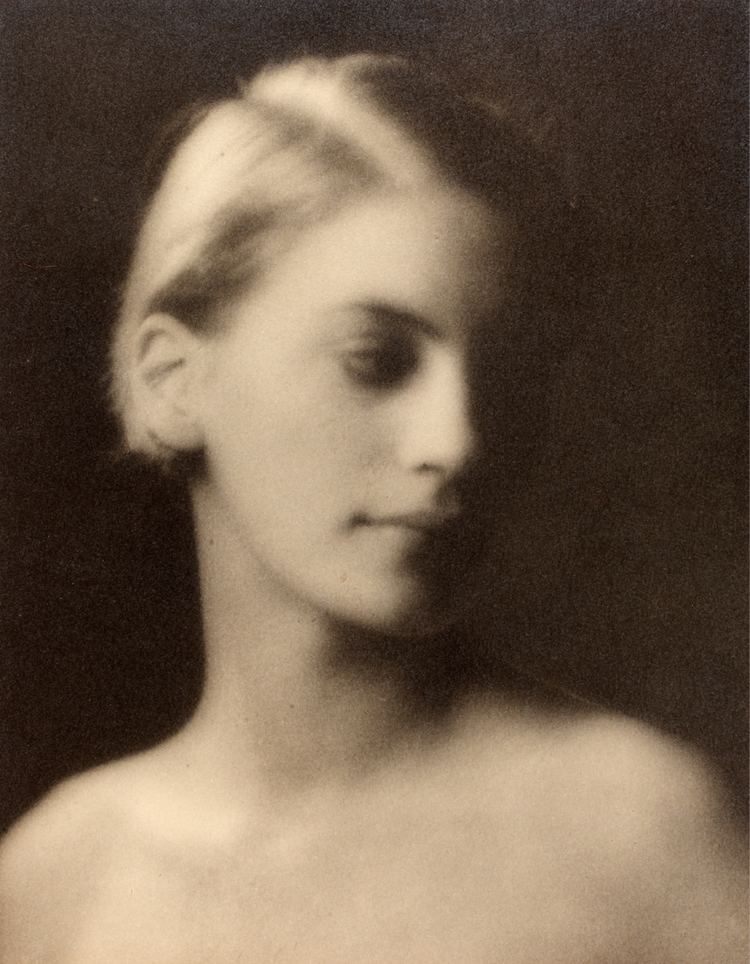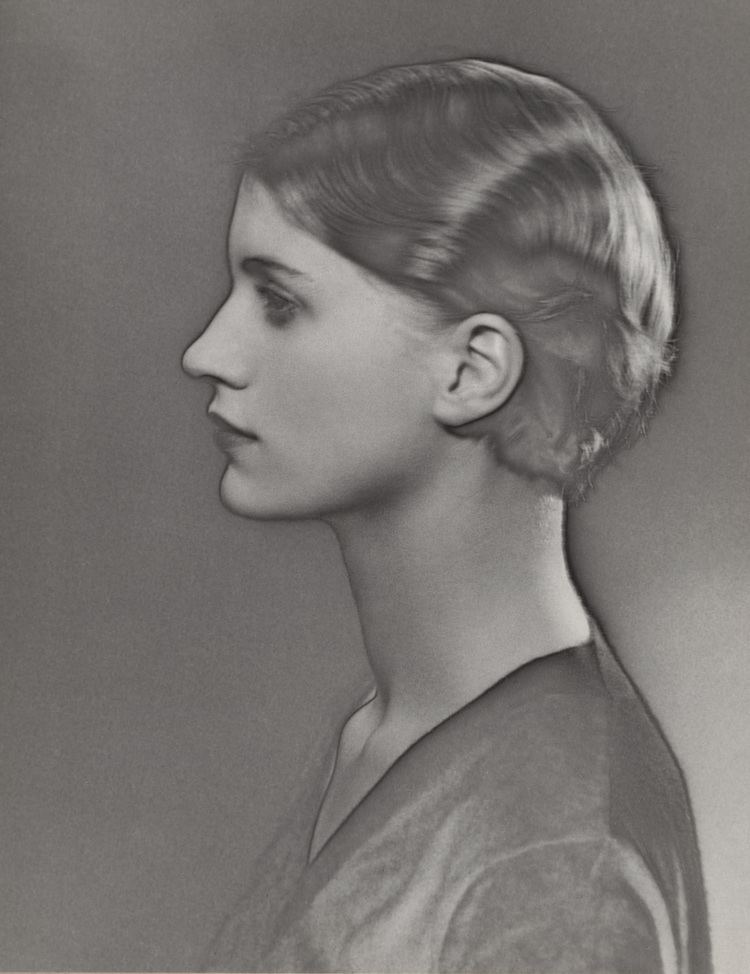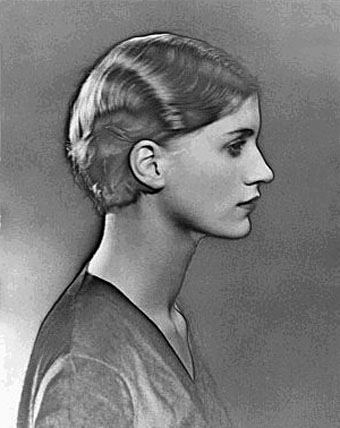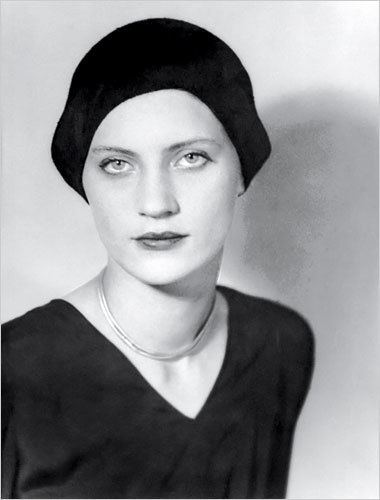Nationality American Name Lee Miller Website Lee Miller Archives | Role Photographer | |
 | ||
Full Name Elizabeth Miller Similar People | ||
Man Ray Portraits: Lee Miller's house
Elizabeth "Lee" Miller, Lady Penrose (April 23, 1907 – July 21, 1977), was an American photographer. Born in Poughkeepsie, New York, in 1907, she was a successful fashion model in New York City in the 1920s before going to Paris, where she became an established fashion and fine art photographer. During the Second World War, she became an acclaimed war correspondent for Vogue, covering events such as the London Blitz, the liberation of Paris, and the concentration camps at Buchenwald and Dachau.
Contents
- Man Ray Portraits Lee Millers house
- Lee miller surrealist photography
- Early life
- Modeling
- Photography
- World War II
- Life in Britain
- Death
- Legacy
- References

Lee miller surrealist photography
Early life

Miller was born on April 23, 1907, in Poughkeepsie, New York. Her parents were Theodore and Florence Miller (née MacDonald). Her father was of German descent, and her mother of Scottish and Irish descent. She had a younger brother named Erik, and an older brother named John. Theodore always favored Lee, and he often used her as a model for his amateur photography. When she was seven years old, she was raped while staying with a family friend in Brooklyn and infected with gonorrhea. She traveled to Europe in 1925, staying in Paris to study art. Miller's time in Europe was brief, being called back to New York by her father. Upon her return, Miller enrolled in the Art Students League, New York.
Modeling

Lee's father introduced Lee and her brothers to photography at an early age. She was his model – he took many stereoscopic photographs of his nude teenage daughter – and he also showed her technical aspects of the art. Aged 19 she nearly stepped in front of a car on a Manhattan street but was prevented by Condé Nast, the publisher of Vogue. This incident helped launch her modeling career; she appeared illustrated in a blue hat and pearls in a drawing by George Lepape on the cover of the Vogue edition of March 15, 1927. Miller's look was exactly what Vogue's then editor-in-chief Edna Woolman Chase was looking for to represent the emerging idea of the "modern girl."

For the next two years she was one of the most sought-after models in New York, photographed by leading fashion photographers including Edward Steichen, Arnold Genthe, Nickolas Muray and George Hoyningen-Huene. A photograph of Miller by Steichen was used to advertise Kotex menstrual pads, without her consent, effectively ending her career as a fashion model. She was hired by a fashion designer in 1929 to make drawings of fashion details in Renaissance paintings but in time grew tired of this and found photography more efficient.
Photography
In 1929, Miller traveled to Paris with the intention of apprenticing herself to the Surrealist artist and photographer Man Ray. Although, at first, he insisted that he did not take students, Miller soon became his model and collaborator (announcing to him, "I'm your new student"), as well as his lover and muse. While she was in Paris, she began her own photographic studio, often taking over Man Ray's fashion assignments to enable him to concentrate on his painting. In fact, many of the photographs taken during this period and credited to Man Ray were actually taken by Miller. Together with Man Ray, she rediscovered the photographic technique of solarisation. She was an active participant in the surrealist movement, with her witty and humorous images. Amongst her circle of friends were Pablo Picasso, Paul Éluard, and Jean Cocteau, who was so mesmerized by Miller's beauty that he coated her in butter and transformed her into a plaster cast of a classical statue for his film, The Blood of a Poet (1930)). During a dispute with lover Man Ray, regarding the attribution of their co-produced work, Man Ray is said to have slashed an image of Miller's neck with a razor.
After leaving Man Ray and Paris in 1932, she returned to New York and established a portrait and commercial photography studio (with $10,000 worth of backing from Christian Holmes II and Cliff Smith) with her brother Erik (who had been working for the fashion photographer Toni von Horn) as her darkroom assistant. Miller rented two apartments in a building one block from Radio City Music Hall. One of the apartments became her home while the other became the Lee Miller Studio. Clients of the Lee Miller Studio included BBDO, Henry Sell, Elizabeth Arden, Helena Rubinstein, Saks Fifth Avenue, I. Magnin and Co., and Jay Thorpe. During 1932 Miller was included in the Modern European Photography exhibition at the Julien Levy Gallery in New York and in the Brooklyn Museum's exhibition "International Photographers" where she was featured with Laszlo MoholyNagy, Cecil Beaton, Margaret Bourke-White, Tina Modotti, Charles Sheeler, Man Ray, and Edward Weston. In response to the exhibition, Katherine Grant Sterne wrote a review in Parnassus in March 1932, noting that Miller "has retained more of her American character in the Paris milieu. The very beautiful Bird Cages at Brooklyn; the study of a pink-nailed hand embedded in curly blond hair which is included in both the Brooklyn and the Julien Levy show; and the brilliant print of a white statue against a black drop, illumine the fact rather than distort it."
In 1933, Julien Levy gave Miller the only solo exhibition of her Life. Among her portrait clients were the surrealist artist Joseph Cornell, actresses Lilian Harvey and Gertrude Lawrence, and the African-American cast of the Virgil Thomson–Gertrude Stein opera Four Saints in Three Acts (1934).
In 1934, Miller abandoned her studio to marry the Egyptian businessman and engineer Aziz Eloui Bey, who had come to New York to buy equipment for the Egyptian Railways. Although she did not work as a professional photographer during this period, the photographs she took while living in Egypt with Eloui, including Portrait of Space, are regarded as some of her most striking surrealist images. In Cairo, Miller took a photograph of the desert near Siwa that Magritte saw and used as inspiration for his 1938 painting "Le Baiser." By 1937, Miller had grown bored with her life in Cairo and returned to Paris, where she met the British surrealist painter and curator Roland Penrose, whom she later would marry. Also in 1934, Miller contributed an object to the "Surrealist Objects and Poems" exhibition at the London Gallery. Four of her photographs (Egypt (1939), Roumania (1938), Libya (1939), and Sinai (1939)) in the 1940 exhibition "Surrealism To-Day" at the Zwemmer Gallery in London. The following year her work was featured in the New York Museum of Modern Art exhibition "Britain at War." Her photographs were not included in another exhibition until 1955, when her work was displayed in the renowned "Family of Man" exhibition curated by Edward Steichen, the director of the Museum of Modern Art's (MOMA) Department of Photography in New York City.
World War II
At the outbreak of World War II, Miller was living in Hampstead in London with Roland Penrose when the bombing of the city began. Ignoring pleas from friends and family to return to the US, Miller embarked on a new career in Photojournalism as the official war photographer for Vogue, documenting the Blitz. Miller was accredited into the U.S. Army as a war correspondent for Condé Nast Publications from December 1942. She teamed up with the American photographer David E. Scherman, a LIFE correspondent on many assignments. Miller traveled to France less than a month after D-Day and recorded the first use of napalm at the siege of St. Malo, as well as the liberation of Paris, the battle for Alsace, and the horror of the Nazi concentration camps at Buchenwald and Dachau. A photograph by Scherman of Miller in the bathtub, with a shower hose looped in the center behind her head, recollecting a noose, taken at Adolf Hitler's apartment in Munich is one of the most iconic images from the Miller–Scherman partnership. Being one of the first to arrive at Hitler's secret apartments, Miller admits "I had his address in my pocket for years." After taking the bathtub picture, Miller bathed in Hitler's tub and slept in his bed. During this time, Miller photographed dying children in a Vienna Hospital, peasant life in post-war Hungary, corpses of Nazi officers and their families, and finally, the execution of Prime Minister László Bárdossy. After the war, she continued to work for Vogue for a further two years, covering fashion and celebrities.
Life in Britain
After returning to Britain from central Europe, Miller started to suffer from severe episodes of clinical depression and what later became known as post-traumatic stress syndrome. She began to drink heavily, and became uncertain about her future. In 1946, she traveled with Roland Penrose to the United States, where she visited Man Ray in California. After she discovered she was pregnant by Penrose with her only son, Antony, she divorced Bey and, on May 3, 1947, married Penrose. Their son, Antony Penrose, was born in September 1947.
In 1949, the couple bought Farley Farm House in Chiddingly, East Sussex. During the 1950s and 1960s, Farley Farm became a sort of artistic Mecca for visiting artists such as Picasso, Man Ray, Henry Moore, Eileen Agar, Jean Dubuffet, Dorothea Tanning, and Max Ernst. While Miller continued to do the occasional photo shoot for Vogue, she soon discarded the darkroom for the kitchen, becoming a successful gourmet cook. According to her housekeeper Patsy she specialized in "historical food" like roast suckling pig as well as fare such as marshmallows in a cola sauce (especially made to annoy English critic Cyril Connolly who told her Americans could not cook). She also provided photographs for biographies Penrose wrote on Picasso and Antoni Tàpies. However, images from the war, especially the concentration camps, continued to haunt her and she started on what her son later described as a "downward spiral". Her depression may have been accelerated by her husband's long affair with the trapeze artist Diane Deriaz.
Miller was investigated by the British security service MI5 during the 1940s and 50s, on suspicion of being a Soviet spy.
In October 1969, Miller was asked in an interview with a New York Times reporter what it was that drew her to photography. Her response was that it was "a matter of getting out on a damn limb and sawing it off behind you."
Death
Miller died from cancer at Farley Farm House in 1977, aged 70. She was cremated, and her ashes were spread through her herb garden at Farley.
Legacy
Miller's work has served as inspiration for Gucci's Frida Giannini, Ann Demeulemeester and Alexander McQueen. Playwright David Hare comments, "Today, when the mark of a successful iconographer is to offer craven worship of wealth, or yet more craven worship of power and celebrity, it is impossible to imagine an artist of Lee's subtlety and humanity commanding the resources of a mass-market magazine." Mark Haworth-Booth, curator of "The Art of Lee Miller," has said "her photographs shocked people out of their comfort zone" and that "she had a chip of ice in her heart...she got very close to things...Margaret Bourke-White was far away from the fighting, but Lee was close. That's what makes the difference--Lee was prepared to shock."
In 1932 for the Poughkeepsie Evening Star, Lee Miller stated that photography was "perfectly suited to women as a profession...it seems to me that women have a bigger chance at success in photography than men...women are quicker and more adaptable than men. And I think they have an intuition that helps them understand personalities more quickly than men."
Throughout her life, Miller did very little to promote her own photographic work. That Miller's work is known today is mainly due to the efforts of her son, Antony Penrose who has been studying, conserving, and promoting his mother's work since the early 1980s. He discovered sixty thousand or so photographs, negatives, documents, journals, cameras, love letters and souvenirs in cardboard boxes and trunks in Farley Farm's attic after his mother's death, owns the house and offers tours of the works of Miller and Roland Penrose. The house is home to the private collections of Miller and Penrose, their own work and some of their favourite pieces of art. In the dining room, the fireplace was decorated in vivid colours by Penrose. Her pictures are accessible at the Lee Miller Archive.
In 1985, Penrose published the first biography of Miller, entitled The Lives of Lee Miller. Since then, a number of books, mostly accompanying exhibitions of Miller's photographs, have been written by art historians and writers such as Jane Livingstone, Richard Calvocoressi, and Mark Haworth-Booth. Penrose and David Scherman collaborated on the book Lee Miller's War: Photographer and Correspondent With the Allies in Europe 1944–45, in 1992. Interviews with Penrose form the core of the 1995 documentary Lee Miller: Through the Mirror, made with Scherman and writer-director Sylvain Roumette.
The audiobook Surrealism Reviewed was published in 2002, and a 1946 radio interview with Miller can be heard on it.
In 2005, Miller's life story was turned into a musical, Six Pictures Of Lee Miller, with music and lyrics by British composer Jason Carr. It was premiered at the Chichester Festival Theatre, West Sussex. Also in 2005, Carolyn Burke's substantial biography, Lee Miller, A Life, was published in the U.S. by Alfred A. Knopf and in the U.K. by Bloomsbury.
In 2007, Traces of Lee Miller: Echoes from St. Malo, an interactive CD and DVD about Miller's war photography in St. Malo, was released with the support of Hand Productions and Sussex University.
In 2015, an exhibition of her photographs at the Scottish National Portrait Gallery, Lee Miller and Picasso, focussed "on the relationship between Lee Miller, Roland Penrose and Pablo Picasso." In the same year, a work of historical fiction, The Woman in the Photograph, by Dana Gynther, was published. It builds its story around Miller's affair with Ray in Paris circa 1930.
